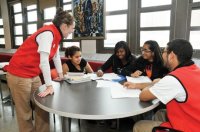Why Mathematical Practices Matter as Much as the Content
Your content has been saved!
Go to My Saved Content.I have a confession to make: at some point this year, I realized that there’s a difference between the teacher I would love to be and the teacher I currently am.
Most teachers want to do interdisciplinary projects, project-based learning and every other education phrase with the words "exploration" and "project" in it. Despite evidence to the contrary, their reality of having to teach directly to a standardized test (ultimately affecting their municipality's perception of them) casts a longer shadow on them than even the bravest of us want to admit.
In math, the need to stand in front of the classroom particularly rings true, not just because of the stakes, but because of the long precedent set by previous math teachers to do exactly that.
Yet math teachers simultaneously know that, in order for students to solve problems on their own, we have to teach them not just the "what" but the "how." "What" equals content, but I’m expanding the definition of "how" beyond simply learning skills and procedures. The "how" should be about how to help students think more critically about the problems in front of them.
In other words, the approaches and uses of the tools students learn in math matter just as much as the topics and situations in which they apply.
An Expanded Skillset
The Common Core State Standards seem to address this well with their seven mathematical practices, but if the practitioners of the CCSS do as we've done in the past, then we've missed another opportunity to fortify students' knowledge of math. Whether they're learning fractions, exponents or the distributive property, they have to learn how to approach mathematical problems.
For instance, would I rather my students learn how to find the slope of a linear relationship or how to make sense of the answer after they've figured it out? One might say you can't make sense of the resulting quotient without actually finding the quotient, but I submit to you that, without making sense of the slope (either by explaining it or showing another representation), they won't know whether the response they got actually made sense. Students ought to have the skills to self-correct, or at least think twice before looking at a response and moving on.
Simply finding the answer is only one part of math.
Now, unlike the topics (or content) we teach in math, teaching students how to approach a problem will feel more like a soft skill to teachers, in the same category as recognizing when a kid needs to go to the restroom or getting a student a tissue five seconds before you know they'll sneeze all over the pencil you lent them. Teaching students how to disagree with another person's argument carefully (and factually) or how to move on to the next problem without constantly checking with you (I'm still working on this) demands a certain dexterity from educators, and a consistent eye on making sure those sorts of behaviors flourish.
Rather than just trying to sift through our 800-page textbooks by chapter or blaze through a curriculum map, let's focus on developing mathematicians. Many of the things we take for granted, like teaching students how to ask better questions or picking apart word problems, actually make students better at math.
